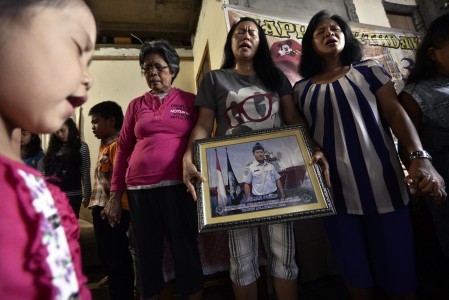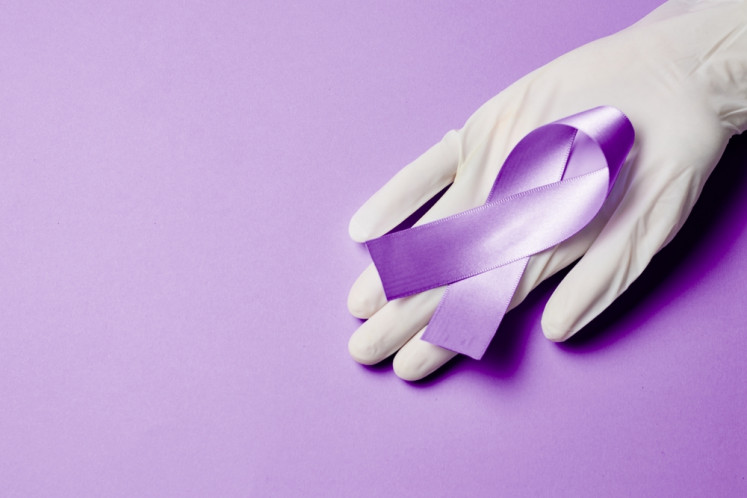Popular Reads
Top Results
Can't find what you're looking for?
View all search resultsPopular Reads
Top Results
Can't find what you're looking for?
View all search resultsA hostage's account of Abu Sayyaf kidnapping
Change text size
Gift Premium Articles
to Anyone
 The family of Julian Philip conducts a pray for the safety of Julian at their home in Sasaran, Minahasa regency, North Sulawesi, on April 6. Julian and nine other sailors returned home on Sunday after being held captive by the notorious Abu Sayyaf group for more than a month. (Antara/Adwit B Pramono)
The family of Julian Philip conducts a pray for the safety of Julian at their home in Sasaran, Minahasa regency, North Sulawesi, on April 6. Julian and nine other sailors returned home on Sunday after being held captive by the notorious Abu Sayyaf group for more than a month. (Antara/Adwit B Pramono)
I
t was in the afternoon on March 25 when 10 Indonesian sailors on board tugboat Brahma 12 and barge Anand 12, en route to the Philippines, noticed two speedboats approaching their vessels. They felt no suspicion or alarm, as the approaching men were all decked out in the uniform of the Philippine national police, crewmember Julian Philip said on Monday.
"We initially thought they were from the official authorities," said the native of Minahasa regency in North Sulawesi.
However, as the vessels drew up, the men on the speedboats jumped onto the Indonesian vessels, wielding M14 and M16 guns, their bodies draped with reload bullets.
From then, the crews knew their vessels were being hijacked, Julian said. The hijackers then proceeded to tie up all people on board; several crewmen were tied with ropes while others were placed in handcuffs.
"We begged them to release us from our bindings; we said we wouldn't fight back and would follow their orders," said the deck officer of the Brahma 12, speaking to reporters at the Foreign Ministry in Jakarta.
They were eventually released from their bounds. The hijackers then attached the two vessels to their speedboats and headed eastward toward Tawi-Tawi Island in the Sulu Archipelago in the southwestern Philippines.
Along the way, the militants ordered for the barge, which was carrying 7,000 tons of coal, to be detached. By the time they had reached the northern part of Tawi-Tawi, they had also abandoned the tugboat.
Julian and his nine colleagues were split up four days into the captivity and the groups continuously moved locations every few days, supposedly for their own safety, according to their captors.
"Our safety was maintained. Perhaps they didn't want any of the hostages to do because they thought that if one were to die, they wouldn't receive any ransom money," Julian conjectured.
His and his fellows’ release came as a surprise.
"We were just suddenly put in a car, dropped off at a location and told to find the governor's house," Julian said, explaining the story behind their sudden arrival at the house of Sulu Governor Abdusakur Tan II.
A helicopter then took the 10 men to the city of Zamboangan where they were officially questioned by local authorities. From there, they were flown by plane to Balikpapan, East Kalimantan, arriving at Halim Perdanakusuma Airport in East Jakarta at 11:30 p.m. on Sunday.
The 10 were finally allowed to return to their families the following day after doctors confirmed they were in good health.
No details of the release have been disclosed by the government.
The government claimed that “total diplomacy” was the reason behind the success and no ransom paid. The group had demanded a ransom of 50 million pesos or around Rp 14 billion (US$1.06 million) for the 10 hostages.
Foreign Minister Retno LP Marsudi said the rescue efforts had been conducted in collaboration with many parties.
The government-led rescue efforts included both the Indonesian and Philippine governments, as well as other relevant parties, all of whom contributed to the success of the negotiation and diplomacy processes, she added.
The government is continuing in its efforts to rescue four other Indonesians who were taken hostage by Abu Sayyaf in a different incident in mid-April and still remain in captivity. (rin)









